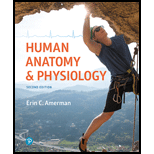
Explain why the skin is an organ.
To review:
The rationale behind skin being an organ.
Introduction:
Skin or the integument system provides the coveringover the body. The skin performs various functions other than the protection of the body. However, the skin does not get recognition as an organ from most of the people.
Explanation of Solution
The organ can be defined as a group of different types of tissues that perform together to accomplish various functions. Integument system is made up of different tissues. Skin is a cutaneous membrane. It is made up of two different layers, namely, epidermis and dermis.
The epidermis is made up of keratinized squamous epithelial cells. The dermis is made up of loose connective tissues and dense irregular connective tissues. The hypodermis is the layer beneath the skin made up of loose connective tissues. Blood is supplied to the dermis via the capillary network.
The skin consists of various structures like sebaceous glands, sweat glands, hair, and nails. Muscle tissues are also present in the skin attached to the base of hair. All these different types of tissues and structures help in performing different kinds of functions like protection, thermoregulation, excretion, homeostasis maintenance, water-electrolyte balance, andvitamin D synthesis. Thus, the skin fulfills the criteria necessary for an organ.
Therefore, it can be concluded that the skin is made up of different tissues that help to perform different functions. Thus, the skin is an organ that is supplied with blood, has connective tissues, and provides protection to the body.
Want to see more full solutions like this?
Chapter 5 Solutions
Pearson eText Human Anatomy & Physiology -- Instant Access (Pearson+)
- What is behavioral adaptarrow_forward22. Which of the following mutant proteins is expected to have a dominant negative effect when over- expressed in normal cells? a. mutant PI3-kinase that lacks the SH2 domain but retains the kinase function b. mutant Grb2 protein that cannot bind to RTK c. mutant RTK that lacks the extracellular domain d. mutant PDK that has the PH domain but lost the kinase function e. all of the abovearrow_forwardWhat is the label ?arrow_forward
- Can you described the image? Can you explain the question as well their answer and how to get to an answer to an problem like this?arrow_forwardglg 112 mid unit assignment Identifying melting processesarrow_forwardGive only the mode of inheritance consistent with all three pedigrees and only two reasons that support this, nothing more, (it shouldn't take too long)arrow_forward
- Oarrow_forwardDescribe the principle of homeostasis.arrow_forwardExplain how the hormones of the glands listed below travel around the body to target organs and tissues : Pituitary gland Hypothalamus Thyroid Parathyroid Adrenal Pineal Pancreas(islets of langerhans) Gonads (testes and ovaries) Placentaarrow_forward
 Human Physiology: From Cells to Systems (MindTap ...BiologyISBN:9781285866932Author:Lauralee SherwoodPublisher:Cengage Learning
Human Physiology: From Cells to Systems (MindTap ...BiologyISBN:9781285866932Author:Lauralee SherwoodPublisher:Cengage Learning Human Biology (MindTap Course List)BiologyISBN:9781305112100Author:Cecie Starr, Beverly McMillanPublisher:Cengage Learning
Human Biology (MindTap Course List)BiologyISBN:9781305112100Author:Cecie Starr, Beverly McMillanPublisher:Cengage Learning Anatomy & PhysiologyBiologyISBN:9781938168130Author:Kelly A. Young, James A. Wise, Peter DeSaix, Dean H. Kruse, Brandon Poe, Eddie Johnson, Jody E. Johnson, Oksana Korol, J. Gordon Betts, Mark WomblePublisher:OpenStax College
Anatomy & PhysiologyBiologyISBN:9781938168130Author:Kelly A. Young, James A. Wise, Peter DeSaix, Dean H. Kruse, Brandon Poe, Eddie Johnson, Jody E. Johnson, Oksana Korol, J. Gordon Betts, Mark WomblePublisher:OpenStax College





